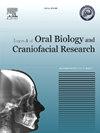锥形束计算机断层扫描对颞下颌关节紊乱与非颞下颌关节紊乱患者下颌髁突的分形比较分析
Q1 Medicine
Journal of oral biology and craniofacial research
Pub Date : 2025-04-09
DOI:10.1016/j.jobcr.2025.03.017
引用次数: 0
摘要
颞下颌关节(TMJ)的解剖结构和显微结构复杂。TMJ的多因素疾病可能影响关节的肌肉骨骼和骨骼结构。在颞下颌疾病(TMDs)的早期发现这些变化是非常有益的,以防止其发展。有几个病理条件可以影响下颌髁小梁骨在TMJ。为了分析这些变化,可以通过使用分形维数分析来测量它们,因为它们是自然分形。的目标,目的应用分形分析方法对下颌髁的骨小梁形态进行研究,探讨下颌髁的分形维数变化对TMD的诊断价值。方法将120例受试者分为对照组(非TMD 60例)和研究组(TMD 60例)。该研究包括根据RDC/TMD轴i诊断为TMD的参与者;Axis-II(研究诊断标准,2014)。锥豆计算机断层扫描(CBCT)图像被捕获并转换为JPEG图像。分形维数分析进行了对小梁骨的髁部分。使用Image J软件1.51版程序(美国国立卫生研究院,Bethesda, MD @;https://imagej.nih.gov/ij/download.html).ResultsThe本研究发现TMD受试者的分形值显著低于对照组(p <;左右两侧分别为0.001 p <;0.021)。结论研究组分形值低于对照组。本研究为每种类型的TMD提供了额外的假设分形值。CBCT的应用可提高TMD的诊断水平。本文章由计算机程序翻译,如有差异,请以英文原文为准。

Comparative fractal analysis of mandibular condyles in temporomandibular disorder and non-temporomandibular disorder patients using cone-beam computed tomography
Introduction
Temporomandibular joint (TMJ) anatomy and microstructure is complex. Multifactorial disorders of the TMJ may affect the musculoskeletal and osseous structures of the joint. It is highly beneficial to detect these changes early in the development of temporomandibular disorders (TMDs) in order to prevent their progression. There are several pathological conditions that can affect the trabecular bone of the mandibular condyle in the TMJ. In order to analyse these changes, it is possible to measure them through the use of fractal dimensional analysis, as they are natural fractals.
Aim & objective
Fractal analysis was used in this study to examine the trabecular pattern of the mandibular condyle, with the objective of assessing fractal dimension changes in mandibular condyles for TMD diagnosis.
Methods
The 120 subjects are divided into two groups, a Control group (non-TMD's-60 each) and a Study group (TMD's-60 each). The study includes participants diagnosed with TMD's according to RDC/TMD Axis -I & Axis-II (Research diagnostic criteria,2014). Cone bean computed Tomography (CBCT) images are captured and converted into JPEG images. A fractal dimensional analysis is performed on the condylar portion of the trabecular bone. With Image J software version 1.51 program (National Institutes of Health, Bethesda, MD @; https://imagej.nih.gov/ij/download.html).
Results
The present study found that subjects with TMD had significantly lower fractal values than controls (p < 0.001 on right side and left side p < 0.021).
Conclusion
The study group had lower fractal values than the control group. This study in additional hypothesized fractal values for each type of TMD. The use of CBCT can enhance the diagnosis of TMD.
求助全文
通过发布文献求助,成功后即可免费获取论文全文。
去求助
来源期刊

Journal of oral biology and craniofacial research
Medicine-Otorhinolaryngology
CiteScore
4.90
自引率
0.00%
发文量
133
审稿时长
167 days
期刊介绍:
Journal of Oral Biology and Craniofacial Research (JOBCR)is the official journal of the Craniofacial Research Foundation (CRF). The journal aims to provide a common platform for both clinical and translational research and to promote interdisciplinary sciences in craniofacial region. JOBCR publishes content that includes diseases, injuries and defects in the head, neck, face, jaws and the hard and soft tissues of the mouth and jaws and face region; diagnosis and medical management of diseases specific to the orofacial tissues and of oral manifestations of systemic diseases; studies on identifying populations at risk of oral disease or in need of specific care, and comparing regional, environmental, social, and access similarities and differences in dental care between populations; diseases of the mouth and related structures like salivary glands, temporomandibular joints, facial muscles and perioral skin; biomedical engineering, tissue engineering and stem cells. The journal publishes reviews, commentaries, peer-reviewed original research articles, short communication, and case reports.
 求助内容:
求助内容: 应助结果提醒方式:
应助结果提醒方式:


